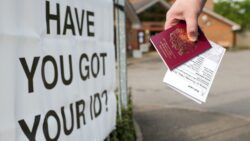May elections 2023 – You MUST have photo ID, what you need to know
May 4 2023 will see voters in some parts of England and Northern Ireland head to the polls to choose new councillors.
The deadline for registering to vote in England has now passed, whilst for those in Northern Ireland, the deadline to register to vote by post or proxies 26 April, or 28 April to vote in person.
More than 8,000 seats will be contested at 230 councils across England.
Bedford, Leicester, Mansfield and Middlesborough will also hold their Mayoral elections.
11 council elections will be held on 18 May in Northern Ireland.
There are no elections taking place in Scotland or Wales.
Click here to find out if you’re eligible to vote
How can I vote in the May elections?
- In person at your polling station
- By post
- By nominating a proxing to vote on your behalf
Voters (and proxies) must be:
- aged 18 or over
- registered at an address in the area where they want to vote
- a British citizen, an Irish or EU citizen or eligible Commonwealth citizen
- not legally excluded from voting
Do I need to register to vote?
Yes. But in England, the deadline to register to vote in person, by proxy or by post has passed. If you missed the deadline to nominate a proxy but then find you can’t vote in person, you can apply for an emergency proxy vote before 17:00 on polling day.
In Northern Ireland, the deadline to register to vote by post or proxy is 17:00 BST on 26 April; to vote in person you must register by 23:59 BST on 28 April.
Do I need photo ID to vote in the May elections?
Yes. This is a big one. For the first time, from 4 May 2023, voters in England must show photo ID to vote in person.
You don’t need to bring your poll card.
There are 22 forms of valid ID including:
- passports
- driving licences
- Older or Disabled Person’s bus passes
- Oyster 60+ cards
You can use an out-of-date ID as long as you look the same.
An estimated two million people without the right ID can sign up for a free Voter Authority Certificate. Applications close on 25 April at 17:00 BST, but you must already have applied to vote in person.
Voter ID has been required in Northern Ireland since 2003.
What happens next?
Voters usually have one vote for each available seat in an election area (known as a ward or division). Large wards may have several seats.

Whoever receives the most votes wins.
Northern Ireland uses the single transferable vote (STV) system – where voters rank candidates in order of preference.
Please read your ballot paper carefully before you cast your vote.
Over 60 English councils will likely see their results come in overnight, with the rest announced throughout the day on Friday 5 May.
In Northern Ireland votes are not counted overnight so expect to see results coming in on 19 May.
Why are these elections important?
The upcoming elections will decide who’s in charge of local public services – and how they are run.
Councils have seen long-term cuts to local government funding dating back to 2010, which followed the global financial crisis.
Many will look at the results of these elections as the last big test for the current UK government ahead of a general election – which is expected in 2024.
The last time these council seats were contested, in May 2019, the Tories lost more than 1,300 seats whilst Labour lost 82. This was around the time Boris Johnson was set to replace Theresa May.
The Conservatives are currently about 15 points behind Labour in national voting polls.





